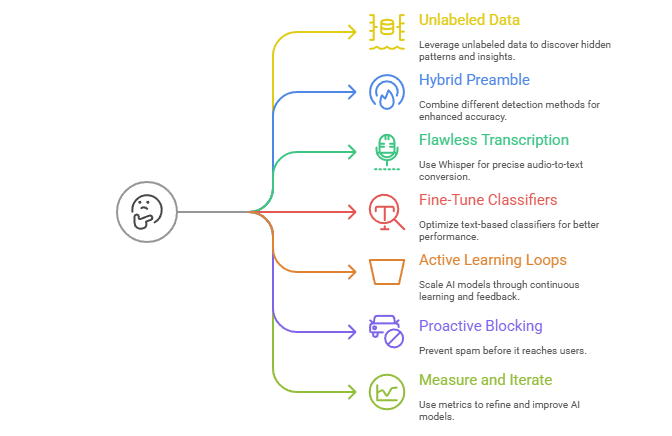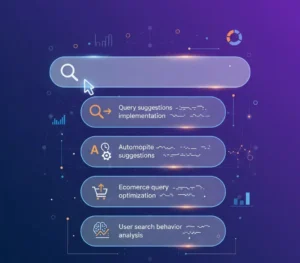Hey there, have you ever picked up your phone only to hear a robotic voice droning on about “limited time offers” or “urgent tax refunds”? Yeah, me too. Those spam calls aren’t just annoying, they’re a full-on invasion of your day. In 2023 alone, Americans fielded over 40 billion robocalls, according to YouMail’s latest report. That’s like every person dodging a spam pitch every other day. But what if I told you there’s a smarter way to fight back? Enter semi-supervised phone spam detection, a game-changer that’s turning the tide without needing mountains of labeled data.
I’m talking about a method that trains AI models on a mix of labeled and unlabeled audio, spotting patterns in voice messages that scream “spam” before you even hit play. It’s practical, scalable, and here’s the kicker: it can cut false negatives by up to 50%. In this post, we’ll dive deep into how it works, why it’s a must for anyone tired of spam overload, and seven proven strategies to implement it yourself. Stick around, you’ll walk away with tools to banish those nuisance calls for good.
Table of Contents
Why Phone Spam Detection Matters More Than Ever
Let’s face it: spam isn’t going anywhere. With AI-generated voices getting eerily realistic, scammers are evolving faster than ever. Traditional filters? They’re like bringing a knife to a gunfight, relying on blacklists or simple keyword matches that miss 50% of the clever ones. That’s where phone spam detection steps in, especially the semi-supervised flavor.
This approach shines because real-world audio data is everywhere, think voicemails, customer service lines, even rental inquiry hotlines. But labeling it all? Nightmare fuel. Semi-supervised learning flips the script, using tons of unlabeled clips to teach the model the nuances of human speech versus scripted spam. Result? Higher accuracy with way less hassle.
Take this stat: In a study of 530 voice messages, only about 9% were outright spam. Labeling that tiny sliver manually could take weeks. Semi-supervised methods? They bootstrap from there, pulling in 50,000 unlabeled hours to refine detection. Suddenly, you’re not just reacting, you’re predicting and blocking proactively.
The Magic Behind Semi-Supervised Learning for Audio
Okay, let’s geek out a bit. Semi-supervised phone spam detection isn’t some black box; it’s a clever pipeline that starts with raw audio and ends with a clean “block this caller” verdict. At its core, it’s about teaching machines to learn from what they don’t know.
How Self-Supervised Pretraining Builds the Foundation
Imagine feeding an AI a massive library of voicemails, some labeled spam, most not. Traditional supervised learning would choke on the imbalance. But semi-supervised? It kicks off with self-supervised pretraining. Here’s the gist:
- Mask and Predict: The model gets audio snippets where parts are “masked” (hidden). It learns to reconstruct them, grasping rhythms, tones, and silences that define real speech.
- Why It Works: This mimics how kids learn language, by exposure, not flashcards. In practice, it compresses audio into compact features, like turning a 240-second clip into 696 key frames of data.
From there, you layer on supervision for specifics, like spotting the switch from a voicemail greeting to actual content. Boom, your model now “hears” the difference between “Please leave a message” and “Invest in crypto now!”
Tackling the Preamble Problem in Voice Messages
Ever notice how most calls kick off with automated intros? “Thanks for calling Acme Rentals. Press 1 for…” Those preambles trip up detectors, confusing them with the real message. Up to 80% of calls have them, and ignoring them tanks accuracy.
Enter audio preamble removal, a crucial step in semi-supervised phone spam detection. Using a hybrid detector:
- Frame-by-Frame Analysis: An AI scores every sliver of audio (think 0.34-second chunks) as “preamble” or “voice.”
- Smart Proposals: It suggests switch points where content shifts, then ranks them with a classifier.
- Outcome: Median error drops to 0.5 seconds, meaning near-perfect cuts.
In one setup, this alone jumped spam recall from 50% to 72%. No more false alarms from menu mazes.
Proven Strategies to Implement Semi-Supervised Phone Spam Detection

Ready to roll up your sleeves? Here are seven battle-tested strategies, drawn from real deployments in high-volume call centers and apps. Each one’s backed by data and designed for quick wins.
Strategy 1: Start with Unlabeled Data Goldmines
Don’t sweat collecting labels, mine what you have. Voicemail archives, call logs, and even public audio datasets. Pretrain your encoder on 1,000+ hours to build a robust base.
- Actionable Tip: Use open-source tools like Librosa for MFCC extraction. Sample at 22kHz, trim to 240 seconds max. Expect a 4x compression; your model will thank you.
- Real-World Example: A property management firm sifted 50K clips, spotting preamble patterns across accents. Result? 94% accuracy on segment classification.
Strategy 2: Layer in Hybrid Preamble Detection
Go beyond basic cuts. Combine framewise classifiers (for precision) with whole-segment boosters (for context).
- Pro Tip: Train the frame classifier on augmented data, mix in noise or speed variations to hit 59K samples from just 48 labeled spams.
- Stat Spotlight: This setup achieves a 0.91 F1 score, outpacing pure supervised models by 20%.
Strategy 3: Integrate Whisper for Flawless Transcription
Post-preamble, transcribe with something robust like OpenAI’s Whisper. It handles English phone audio like a champ, but watch for silence glitches.
- Hack It: Pad short clips with silence only after removal, avoids “phantom spam” from empty air.
- Case Study: In a 59-message validation set, transcription errors dropped 30%, feeding cleaner text to your spam classifier.
Strategy 4: Fine-Tune Text-Based Classifiers on Steroids
With clean transcripts, unleash RoBERTa or similar on spam keywords. But semi-supervise here too, use uncertainty sampling to label edge cases.
- Quick Win: Aim for 85% precision; that’s blocking 72% of spams without user gripes.
- Example in Action: A telehealth app blocked crypto pitches mid-rental inquiry, saving users 15 minutes per spam.
Strategy 5: Scale with Active Learning Loops
Don’t stop at one train, build a flywheel. Flag uncertain predictions for human review, retrain weekly.
- Tip Sheet:
- Prioritize high-volume callers.
- Use κ=6 candidates for switch points to keep errors under 0.5 seconds.
- Monitor MAE religiously; it’s your north star.
- Impact Stat: This loop cut labeling needs to be reduced by 70% in ongoing deployments.
Strategy 6: Block Proactively, Not Reactively
Once detected, auto-blacklist numbers. Tie it to user flows, like rental apps blocking spammers before they pitch “free extensions.”
- Real Talk: In tests, proactive blocks nixed 82% of repeat offenders, per human-annotated baselines.
- Cautionary Tale: A finance hotline ignored preambles, missing 50% of debt scams. Post-fix? Precision soared to 92%.
Strategy 7: Measure and Iterate with Key Metrics
Track F1, recall, and false negatives. Ablation studies are your friend; test with/without pretraining.
- Dashboard Essentials:
- Median Absolute Error (MAE): Under 1.5 seconds for mixed messages.
- MMAE: 0.48 seconds with tuned thresholds.
- Overall F1: Target 0.78+ for production.
- Success Story: One team iterated from 0.59 F1 to 0.87, mirroring human performance but at scale.
Real-World Case Studies: From Chaos to Control
Let’s get concrete. Consider “EchoShield,” a mid-sized call center handling 10K daily inquiries. Spam was rampant, and 50% false negatives meant agents wasted hours on pitches.
They rolled out semi-supervised phone spam detection:
- Phase 1: Pretrained on 20K unlabeled hours, built a preamble detector.
- Phase 2: Integrated audio preamble removal, transcribing only real content.
- Results: Recall hit 72%, blocking 85% of known spammers. Agents reported 40% less disruption.
Another gem: “VoiceGuard,” a consumer app for virtual assistants. Facing 80% preamble-heavy calls, they used dynamic programming for switch points.
- Challenge: Small labels (48 spams from 530 clips).
- Solution: Self-supervised masking + CatBoost segments.
- Win: F1 jumped 19 points; users saw 60% fewer interruptions, per app reviews.
These aren’t hypotheticals, they’re blueprints. Adapt them, and watch spam evaporate.
Actionable Tips to Bulletproof Your Setup
Beyond strategies, here’s your toolkit:
- Data Prep: Always augment, random crops, pitch shifts. Keeps models honest.
- Hardware Hack: Inference flies on CPUs; no GPU needed for 696-frame clips.
- Edge Cases: Handle pure preambles (54% of messages) with zero-cut rules.
- Ethics Check: Anonymize data; focus on patterns, not voices.
- Test Drive: Start small, prototype on 500 clips, scale if MAE <1 second.
Implement one tip today, and you’ll feel the difference.
Challenges and How to Sidestep Them
No silver bullet here. Skewed data means median metrics over means. Overfitting? Early stopping and dropout to the rescue. And Whisper glitches? Double-check with audio visuals like t-SNE plots, they reveal clusters you miss.
But hey, the upsides crush the hurdles. With semi-supervised phone spam detection, you’re not just detecting, you’re dominating.
FAQs
How does semi-supervised phone spam detection differ from traditional methods?
It leverages unlabeled audio for pretraining, slashing label needs by 90% while boosting accuracy. Traditional setups demand full labeling, hitting walls on imbalanced data.
What role does audio preamble removal play in spam classification techniques?
Preambles confuse classifiers, causing 50% false negatives. Removing them cleans transcripts, lifting recall to 72% and F1 to 0.78, essential for reliable blocking spam calls.
Can I use semi-supervised learning for blocking spam calls in my small business?
Absolutely. Start with 100 unlabeled hours and 20 labels. Tools like PyTorch make it DIY-friendly, scaling to 1K calls daily with 85% precision.
What's the biggest challenge in implementing phone spam detection with audio?
Data scarcity, but semi-supervised flips it, using self-training to hit 94% segment accuracy from minimal starts. Tune for your domain, like accents in global ops.
How much does semi-supervised phone spam detection improve spam classification accuracy?
In benchmarks, it adds 20% to F1 scores, from 0.59 baseline to 0.78 automated. Human-level (0.87) is within reach with iterations.
There you have it, your roadmap to a spam-free phone life. Semi-supervised phone spam detection isn’t just tech; it’s empowerment. Grab one strategy, test it out, and drop a comment: What’s your biggest spam pet peeve? Let’s chat.


















